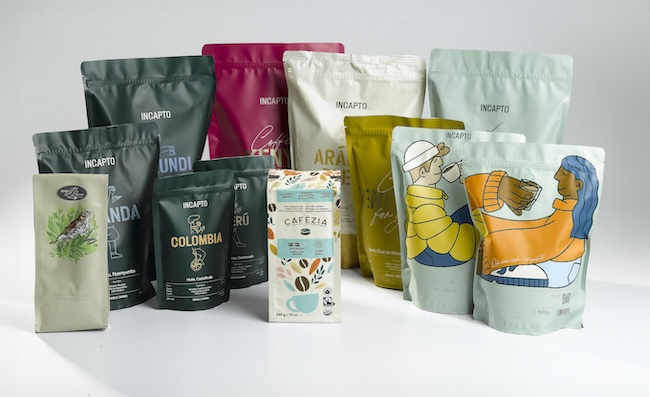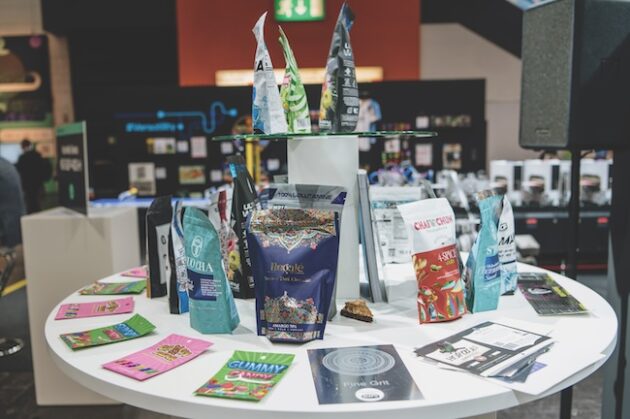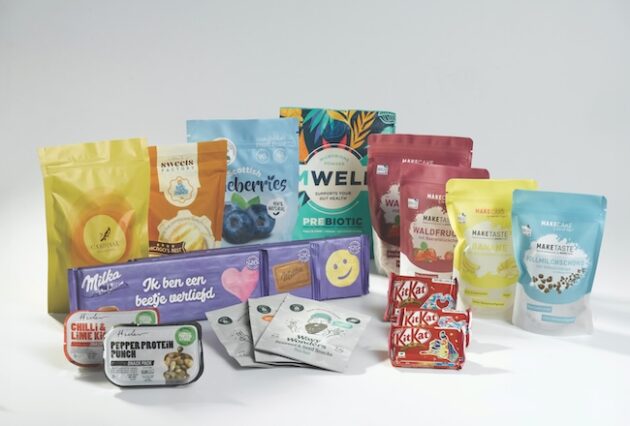
Features
Packaging
Printing
The rise of flexible packaging
Manufacturers must offer flexible packaging services to capitalize on the product’s growing popularity
March 17, 2025 By Jack Kazmierski
 CPG companies are opting for flexible packaging as it’s versatile and offers superior barrier protection. Photos © HP Indigo
CPG companies are opting for flexible packaging as it’s versatile and offers superior barrier protection. Photos © HP Indigo Take a stroll through any grocery store and you’re sure to see aisle after aisle of consumer goods in flexible packaging. The popularity of flexible packaging is undeniably on the rise with CPG companies, and for good reason.
According to Tony Corsillo, VP of growth and client happiness at Tempo Flexible Packaging, today’s boom in flexible packaging is being driven by several factors including economic benefits, extended product shelf life and sustainability demands.
“Consumers are increasingly demanding eco-friendly packaging, and brands are responding by setting ambitious ESG [environmental, social, and governance] targets, and emphasizing corporate responsibility,” says Corsillo. “Flexible packaging aligns perfectly with these goals, offering both sustainability and economic advantages.”
Moreover, flexible packaging uses lightweight materials that require fewer resources to both produce and transport them.

Flexible packaging can meet the unique needs of different industries.
“Its ability to be precisely sized and shaped eliminates excess material, ensuring only what’s necessary is used, which significantly reduces waste,” he says.
Beyond its environmental advantages, flexible packaging delivers cost savings by lowering material use, reducing transportation expenses, and minimizing waste-related costs, which makes it a win for businesses’ bottom lines.
“It also provides superior barrier properties and product protection, which helps extend shelf life and reduce spoilage—an essential benefit for both manufacturers and retailers,” says Corsillo.
Flexible packaging is incredibly versatile, making it suitable for a wide range of consumer products. Corsillo notes that its adaptability in design, material selection, and functionality means there are very few products that wouldn’t benefit from some form of flexible packaging. Whether it’s food and beverages, personal care items, household goods, or even pharmaceuticals, flexible packaging offers customizable solutions that meet the unique needs of different industries.
“Its lightweight nature, superior barrier protection, and ability to accommodate various shapes and sizes make it an ideal choice for many applications,” he says.
Looking at flexible packaging from a cost perspective, Corsillo explains that it can deliver substantial savings, but the extent to which it can “depends on the machinery upgrades and supply chain adjustments required to make the transition. While there may be upfront investment costs, these are often offset by long-term savings in material usage, transportation, and waste reduction, making it a worthwhile investment for many companies.”
Options and priorities
Selecting the right flexible packaging material is a critical decision that should be guided by expert advice, Corsillo adds.
“Partnering with a trusted packaging provider is essential. An experienced partner will take the time to understand your specific goals—whether they’re related to sustainability, cost efficiency, or product protection—and recommend materials and designs that align with your needs and priorities.”
Eli Mahal, head of L&P marketing at HP Indigo, notes that flexible packaging is particularly suitable for food. “If you can move from the two-container strategy [where you have a bag within a cardboard box], and move to just one container, which would be a pouch, then you can save a lot,” he says, adding that this strategy will only work if the end result is consumer-friendly. “Consumers have to accept this type of packaging.”
Mahal adds that the look and feel of the final product is paramount, and that the choice of materials, colours, inks and overall design can convey a range of messages to consumers. For example, a package with a matte finish might convey a message of quality and prestige, while a package that looks more like paper comes across as more environmentally friendly and recyclable.
Printing methods
When it comes to printing methods, Mahal explains some of the pros and cons of flexo, digital and gravure.
“By far, CI flexo is the most common way to make flexible packaging, and solvent inks are commonly used. Then you have different types of lamination—we see primarily solvent-based and solvent-less. When it comes to digital print, most of our customers will use solvent-less to shorten the time between print lamination and delivery. When you need high quality, you can use gravure, and then you also have digital printing.”
Mahal notes that the boom in flexible packaging can offer commercial printers new business opportunities, but that the transition is complex and challenging.
“Commercial printers are facing a relatively stagnant, if not declining market,” he says, “and they’re trying to find new markets. Some will go into packaging, but mostly folding cartons, because they’re using the same type of sheet-based offset technology that they’re more familiar with. So this is an easier diversification strategy for them.”
Other commercial printers will go into labels, Mahal explains.
“They have expertise in processing many jobs and delivering them to market in a very fast time,” he says. “If you look at the close to 400 presses we have worldwide, about a third were bought by label converters that are using this technology to diversify into flexible packaging, primarily standard pouches and shrink sleeves—which can be classified as both flexible packaging and as labels.”
The move into flexible packaging is more complex, Mahal adds, “and it requires a lot of expertise. We have some customers that have made this migration, and have hired experts to help them do it, but moving from commercial printing into flexible packaging is not a very common diversification strategy today.”
Future of flexible packaging

It’s important for packaging providers to recommend materials and designs that align with their client’s business needs and priorities.
Looking towards the years ahead, Corsillo notes that the future of flexible packaging is incredibly exciting, driven by innovation, sustainability, and evolving consumer demands.
Corsillo says that we will see innovations in sustainability, including the continued development of recycle-ready materials and mono-material structures that will improve recyclability. We’re also going to see more smart packaging, wherein technologies such as QR codes, NFC tags and temperature sensors will enhance consumer engagement and product traceability.
Additionally, advances in digital printing and design flexibility will allow for more personalized and targeted packaging options, while functional improvements will improve barrier properties for better protection and longer shelf life.
“The flexible packaging industry is at the forefront of sustainability and innovation, with an ongoing focus on balancing environmental responsibility with high performance and consumer appeal,” says Corsillo. “As technology evolves, the possibilities for packaging solutions will continue to expand, offering CPG companies new ways to enhance their products and reduce their environmental impact.”
This article originally appeared in the Jan./Feb. 2025 issue of PrintAction.

